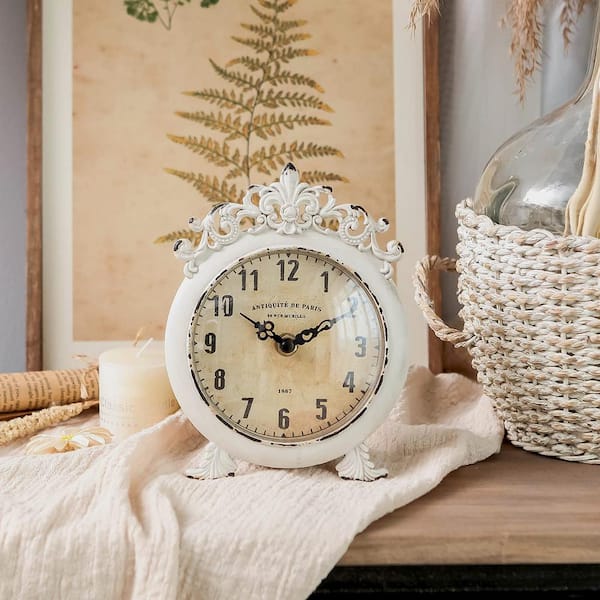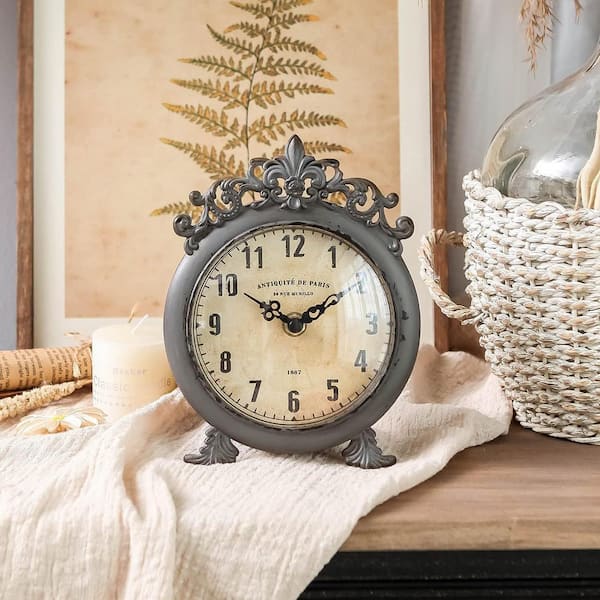Decorative shelf clocks are more than just time-telling devices; they are artistic expressions that can enhance the overall aesthetic of your living space. From vintage designs to modern masterpieces, a well-chosen shelf clock can serve as a focal point in any room. In this article, we will explore the different styles, functionalities, and benefits of decorative shelf clocks. Drawing from personal experience and extensive research, let’s dive into the world of these charming timepieces.
Why Choose Decorative Shelf Clocks?
In today’s fast-paced world, where digital devices dominate, decorative shelf clocks provide a nostalgic touch. They bring warmth and personality to your home. Here’s why you might want to consider incorporating one into your décor:
- Aesthetic Appeal: They add visual interest to your shelves, mantels, and tables.
- Functional Art: A clock serves both a practical and decorative purpose.
- Variety of Styles: Available in numerous designs, materials, and sizes to fit any décor.
- Conversation Starters: Unique clocks can spark interesting discussions with guests.
The History of Shelf Clocks
Understanding the history of clocks can help you appreciate their design and functionality. Shelf clocks have roots in various cultures, evolving through time:
Early Beginnings
The first mechanical clocks appeared in Europe around the 13th century. Initially, they were large structures located in churches, but as technology advanced, smaller versions became popular in homes.
19th Century Innovations
The 1800s saw significant developments in clock-making techniques, leading to the creation of decorative shelf clocks. Styles morphed from functional pieces to intricate designs that reflected the homeowner’s personality.
Modern Trends
Today, decorative shelf clocks blend traditional craftsmanship with innovative designs, making them perfect for any contemporary or classic setting.
Popular Styles of Decorative Shelf Clocks
Let’s explore various styles of decorative shelf clocks you can consider, depending on your personal taste and home décor.

1. Vintage & Antique Clocks
Vintage clocks often feature ornate designs, detailed craftsmanship, and unique components. They add a sense of history to your space.
Pros and Cons of Vintage Clocks
| Pros | Cons |
|---|---|
| Unique designs and craftsmanship | May require regular maintenance |
| Timeless appeal | Potentially higher cost |

2. Modern Minimalist Clocks
Featuring clean lines and simple designs, modern clocks can seamlessly integrate into contemporary interiors.
Pros and Cons of Modern Clocks
| Pros | Cons |
|---|---|
| Sleek and stylish | May lack intricate detailing |
| Easy to incorporate into various décor | Less personalization |

3. Rustic Farmhouse Clocks
With a focus on natural materials and weathered finishes, rustic clocks can bring a cozy feel to your home.
Pros and Cons of Rustic Clocks
| Pros | Cons |
|---|---|
| Warm and inviting look | May not fit modern aesthetics |
| Often eco-friendly materials | Limited variety in designs |

4. Artistic & Quirky Clocks
Artistic clocks can be bold statements in your home, featuring unique shapes, colors, and designs.
Pros and Cons of Artistic Clocks
| Pros | Cons |
|---|---|
| Visually striking | May clash with other decorations |
| A great conversation starter | Possible higher price point |

Key Features to Consider When Choosing a Decorative Shelf Clock
When shopping for a decorative shelf clock, several features can influence your decision:
1. Size and Scale
The size of the clock should complement the space. A large clock can become a statement piece, while a smaller clock can serve as an accent item.

2. Material
Clocks can be made from various materials, including wood, metal, glass, and ceramic. The choice of material affects durability and design aesthetics.
3. Mechanism
Consider if you want a quartz movement for accuracy or a vintage mechanical clock that may require winding.

4. Display Options
Some clocks come with features like LED lights or multiple time zones, adding more functionality to their design.
5. Color and Finish
Choose a color and finish that harmonizes with your existing décor, whether it’s vibrant and bold or subtle and understated.
How to Style Your Decorative Shelf Clock
Incorporating a decorative shelf clock into your home doesn’t have to be complicated. Here are some tips to style it effectively:
1. Pair with Complementary Decor
Style your clock alongside other decorative pieces, such as books, vases, or candles, ensuring a cohesive look.
2. Create Visual Balance
Position your clock at eye level and consider the surrounding elements to maintain balance across your shelf or mantel.
3. Use Clusters
Don’t hesitate to group it with other smaller clocks or unique items to create a curated display.
Comparison of Popular Decorative Shelf Clocks
Here’s a quick comparison of some popular decorative shelf clocks available in the market:
| Brand | Style | Material | Price Range | Best For |
|---|---|---|---|---|
| Howard Miller | Traditional | Wood | $100 – $300 | Classic Interiors |
| Umbra | Modern | Metal/Glass | $50 – $150 | Contemporary Spaces |
| Bulova | Vintage | Wood | $75 – $200 | Eclectic Styles |
| Seiko | Contemporary | Plastic | $30 – $100 | Budget-Friendly Options |
My Personal Experience with Decorative Shelf Clocks
As someone who has always loved to decorate, I’ve found that decorative shelf clocks can transform a space. I remember the first time I placed a vintage clock on my living room shelf—it instantly became the focal point of the room, drawing positive remarks from friends and family. Each tick of the clock brings back memories of family gatherings and quiet afternoons spent reading in that corner. Choosing the right clock is essential, and I’ve experimented with various styles over the years.
Frequently Asked Questions (FAQs)
1. What is the best size for a decorative shelf clock?
The best size for a decorative shelf clock depends on the space you have. Larger clocks are great for open areas while smaller, delicate ones fit well in more confined spaces.
2. Can decorative shelf clocks be used outdoors?
Many decorative shelf clocks are suitable for outdoor use, but ensure you select one made from weather-resistant materials for durability.
3. How do I maintain my decorative shelf clock?
Regular dusting is essential. If it’s a mechanical clock, ensure you follow the manufacturer’s instructions for winding and oiling.
4. Are vintage clocks reliable?
While some vintage clocks can be very reliable, they may require more maintenance compared to modern quartz clocks.
5. What style of clock is best for a minimalist home?
A modern minimalist clock with clean lines and neutral colors will complement the simplicity and elegance of a minimalist home.
Conclusion
Decorative shelf clocks are not just to tell time—they serve as beautiful accents that enhance your home’s ambiance. With various styles and features to choose from, there’s a clock that fits every preference and space. Whether you prefer the charm of vintage designs, the sleekness of modern styles, or the coziness of rustic pieces, incorporating a decorative shelf clock into your décor can create a timeless appeal. So, take your time, explore the options, and find the perfect clock that resonates with your taste!